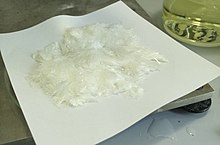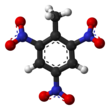
Back Trinitrotolueen Afrikaans تي إن تي (مادة كيميائية) Arabic Trinitrotoluol Azerbaijani ترینیتروتولوئن AZB Трынітраталуол Byelorussian Трынітраталуол BE-X-OLD Тротил Bulgarian ট্রাইনাইট্রোটলুইন Bengali/Bangla Trinitrotoluè Catalan Trinitrotoluen Czech
| |||

| |||
| Names | |||
|---|---|---|---|
| Preferred IUPAC name
2-Methyl-1,3,5-trinitrobenzene[citation needed] | |||
Other names
| |||
| Identifiers | |||
3D model (JSmol)
|
|||
| Abbreviations | TNT | ||
| ChEMBL | |||
| ChemSpider | |||
| DrugBank | |||
| ECHA InfoCard | 100.003.900 | ||
| EC Number |
| ||
| KEGG | |||
PubChem CID
|
|||
| RTECS number |
| ||
| UNII | |||
| UN number | 0209 – Dry or wetted with < 30% water 0388, 0389 – Mixtures with trinitrobenzene, hexanitrostilbene | ||
CompTox Dashboard (EPA)
|
|||
| |||
| |||
| Properties | |||
| C7H5N3O6 | |||
| Molar mass | 227.132 g·mol−1 | ||
| Appearance | Pale yellow solid. Loose "needles", flakes or prills before melt-casting. A solid block after being poured into a casing. | ||
| Density | 1.654 g/cm3 | ||
| Melting point | 80.35 °C (176.63 °F; 353.50 K) | ||
| Boiling point | 240.0 °C (464.0 °F; 513.1 K) (decomposes)[1] | ||
| 0.13 g/L (20 °C) | |||
| Solubility in ether, acetone, benzene, pyridine | soluble | ||
| Vapor pressure | 0.0002 mmHg (20°C)[2] | ||
| Explosive data | |||
| Shock sensitivity | Insensitive | ||
| Friction sensitivity | Insensitive to 353 N | ||
| Detonation velocity | 6900 m/s | ||
| RE factor | 1.00 | ||
| Hazards | |||
| GHS labelling: | |||
   
| |||
| Danger | |||
| H201, H301, H311, H331, H373, H411 | |||
| P210, P273, P309+P311, P370+P380, P373, P501 | |||
| NFPA 704 (fire diamond) | |||
| Lethal dose or concentration (LD, LC): | |||
LD50 (median dose)
|
795 mg/kg (rat, oral) 660 mg/kg (mouse, oral)[3] | ||
LDLo (lowest published)
|
500 mg/kg (rabbit, oral) 1850 mg/kg (cat, oral)[3] | ||
| NIOSH (US health exposure limits): | |||
PEL (Permissible)
|
TWA 1.5 mg/m3 [skin][2] | ||
REL (Recommended)
|
TWA 0.5 mg/m3 [skin][2] | ||
IDLH (Immediate danger)
|
500 mg/m3[2] | ||
| Safety data sheet (SDS) | ICSC 0967 | ||
| Related compounds | |||
Related compounds
|
picric acid hexanitrobenzene 2,4-Dinitrotoluene | ||
Except where otherwise noted, data are given for materials in their standard state (at 25 °C [77 °F], 100 kPa).
| |||
Trinitrotoluene (/ˌtraɪˌnaɪtroʊˈtɒljuiːn/),[4][5] more commonly known as TNT, more specifically 2,4,6-trinitrotoluene, and by its preferred IUPAC name 2-methyl-1,3,5-trinitrobenzene,[citation needed] is a chemical compound with the formula C6H2(NO2)3CH3. TNT is occasionally used as a reagent in chemical synthesis, but it is best known as an explosive material with convenient handling properties. The explosive yield of TNT is considered to be the standard comparative convention of bombs and asteroid impacts. In chemistry, TNT is used to generate charge transfer salts.
- ^ 2,4,6-Trinitrotoluene. inchem.org[dead link]
- ^ a b c d NIOSH Pocket Guide to Chemical Hazards. "#0641". National Institute for Occupational Safety and Health (NIOSH).
- ^ a b "2,4,6-Trinitrotoluene". Immediately Dangerous to Life or Health Concentrations (IDLH). National Institute for Occupational Safety and Health (NIOSH).
- ^ "Trinitrotoluene". Merriam-Webster.com Dictionary.
- ^ "Trinitrotoluene,". Dictionary.com Unabridged (Online). n.d.
© MMXXIII Rich X Search. We shall prevail. All rights reserved. Rich X Search


